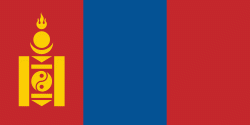Bayanzürkh (Bayandzürh)
Bayanzürkh (Баянзүрх, lit. "rich heart") is a sum (district) of Khövsgöl aimag (province) in Mongolia. The area is about 4,300 sqkm, of which 2,600 sqkm are pasture. In 2000, the sum had 4202 inhabitants, mainly Darkhad. The center, officially named Altraga (Алтрага), is located at the confluence of the Altraga and Beltes rivers, near the Delgermörön river, 127 km northwest of Mörön and 798 km from Ulaanbaatar.
A Bayanzürkh sum was founded, together with the whole aimag, in 1931. In 1933, the bigger part of that sum became Ulaan-Uul sum. In the same year, Bayanzürkh had about 1,100 inhabitants in 499 households, and about 49,000 heads of livestock. Between 1952 and 1990, Bayanzürkh was the seat of the Soyol negdel.
A Bayanzürkh sum was founded, together with the whole aimag, in 1931. In 1933, the bigger part of that sum became Ulaan-Uul sum. In the same year, Bayanzürkh had about 1,100 inhabitants in 499 households, and about 49,000 heads of livestock. Between 1952 and 1990, Bayanzürkh was the seat of the Soyol negdel.
Map - Bayanzürkh (Bayandzürh)
Map
Country - Mongolia
 |
|
| Flag of Mongolia | |
The territory of modern-day Mongolia has been ruled by various nomadic empires, including the Xiongnu, the Xianbei, the Rouran, the First Turkic Khaganate, and others. In 1206, Genghis Khan founded the Mongol Empire, which became the largest contiguous land empire in history. His grandson Kublai Khan conquered China proper and established the Yuan dynasty. After the collapse of the Yuan, the Mongols retreated to Mongolia and resumed their earlier pattern of factional conflict, except during the era of Dayan Khan and Tumen Zasagt Khan. In the 16th century, Tibetan Buddhism spread to Mongolia, being further led by the Manchu-founded Qing dynasty, which absorbed the country in the 17th century. By the early 20th century, almost one-third of the adult male population were Buddhist monks. After the collapse of the Qing dynasty in 1911, Mongolia declared independence, and achieved actual independence from the Republic of China in 1921. Shortly thereafter, the country became a satellite state of the Soviet Union, which had aided its independence from China. In 1924, the Mongolian People's Republic was founded as a socialist state. After the anti-communist revolutions of 1989, Mongolia conducted its own peaceful democratic revolution in early 1990. This led to a multi-party system, a new constitution of 1992, and transition to a market economy.
Currency / Language
| ISO | Currency | Symbol | Significant figures |
|---|---|---|---|
| MNT | Mongolian tögrög | ₮ | 2 |
| ISO | Language |
|---|---|
| MN | Mongolian language |
| RU | Russian language |















